THE BIGGEST, ANGRIEST-LOOKING LOBSTER I HAVE EVER SEEN is sitting on a bed of ice, surrounded by enormous tins of caviar and salmon roe—even the latter, much less expensive than the sturgeon stuff, must be approaching four figures in this quantity, and the caviar approaching five.
A few feet away, in the art gallery next to Arbor in the Green Exchange, a sushi chef is cutting slices of bluefin tuna—responsibly sourced, I have been told, under rules that only allow larger fish to be kept. Next to him are rows and rows of wooden boxes containing uni, sea urchin, from Japan, which looks like rolling orange hills in a Grant Wood painting, and wedged into the ice around them are matsutake mushrooms and wrinkly fruits that look like limes—yuzu, a common Japanese flavor but rarely seen in its actual fruit form in America.
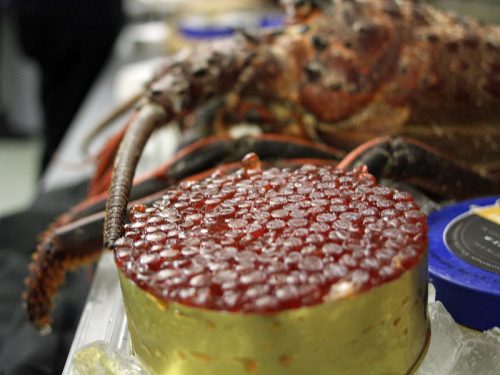
Smoked steelhead trout roe, and Lobsterzilla
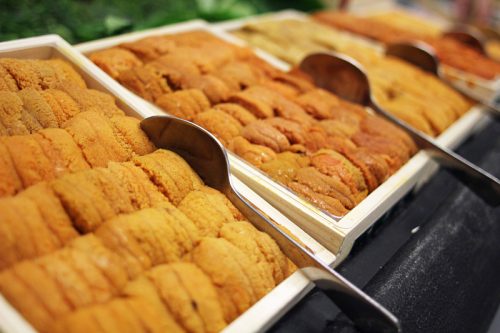
Fields of uni
At the other end of the room Sam Suchoff, chef-owner of The Pig in Chapel Hill, North Carolina, is carving off tastes of supple, funky country ham cured like prosciutto, made from the ham legs from the hogs he barbecues. Around the corner more seafood is on display—giant shrimp, squat crabs that look like little boxers holding up their fists. It’s all destined for a seafood boil. And out on the patio, Theo Gilbert, formerly of Terragusto in Chicago, is grilling skewers of shrimp and A5 miyazaki beef.

Sam Suchoff carving the skin off a piece of ham

Lady Edison country ham, prosciutto-style
It’s a ballers’ feast, and I quickly recognize plenty of chefs and cooks from the Chicago food scene—this is one of the perks of the job, which rarely pays as well as it should. But sometimes someone comes to town and makes it up a little to you, by inviting you to eat better than the millionaires you serve. To eat primally, knocking back the luxuries of your trade in their purest form, and washing them down with beer (from Moody Tongue, serving from the reception desk in the middle of the gallery).
The room is packed and the lines quickly get long—not that I want to try anything. I’ve already tried them that evening; all these goods, on display at the party starting at 10:30 p.m. (for people getting off dinner shift), were used earlier that evening in a dinner I attended at Arbor. I tried the enormous shrimp (delicately poached by Trevor Teich of Claudia), ate the bluefin tuna with shaved truffles and a few drops of a snail-flavored vinegar from Korea (by Arbor’s Leonard Hollander), gnawed on roasted quail out of a “dirty rice” flavored with their own entrails (by Nathan Sears of theWit hotel).
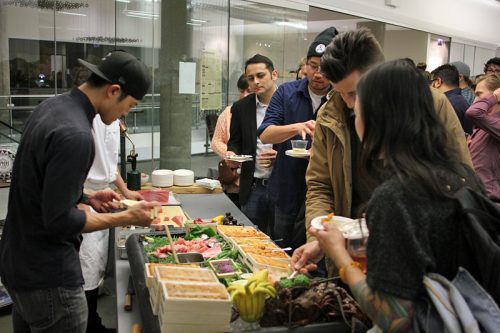
I had caviar (sitting in a cauliflower dip inside fried poori, little Indian puffballs) and country ham prosciutto wrapped around ricotta, and steak-frites in a pool of bearnaise made with uni. All of it accompanied by wines (from Damien Casten’s Candid Wines), introduced with giddy enthusiasm by Arbor’s Chad Little. And, in case you had missed the fact that we were eating all manner of live creatures tonight, many of the tables were decorated with freshly killed pheasants from Vermont. Which (unlike, say, a chicken), could sit unrefrigerated on the tables, because they’re going to wind up hanging for several weeks before they’re served, anyway, as one does with game birds.
What prompted this Dionysian feast, you ask? You ask, did I miss news of an impending comet collision with Earth, prompting these restaurants to break out all the good stuff before we go? No, not a collision, but it is an arrival—the arrival of a company called Regalis Foods into the Chicago market. When you start to see these things on Chicago menus in the next few months—this seafood, these mushrooms, these truffles, this caviar, that ham, maybe even those pheasants—it will trace back to this night, which heralded, with as much splash as possible, the return of a Chicagoan to his home town, remarkable foodstuffs in tow.

Karrie Kimble, David Yourd, Ian Purkayastha, Jane Lowe
DAVID YOURD WAS THE FOURTH GENERATION of a Chicago family business—JDY Meats, a meat and specialty products distributor in the West Loop. “The meat market on Fulton—that’s where we grew up,” he says. “Half of our company was actually meats. And we had suppliers there for twenty years.” Seeing the consolidation in the marketplace for standard meat suppliers, he and his wife Karrie Kimble grew the specialty side, much of it by developing a market for imports from Spain—if you had jamon iberico in Chicago in the 2010s, it probably passed through JDY.
“Part of our business was relying on Fulton Market, and we really saw that imploding, really quickly, with the neighborhood,” Yourd says. “So that was a part of our business that was going to have to change or disappear.” With national distributors like Chef’s Warehouse and D’Artagnan coming into the market for high end foods, they made a decision to sell JDY Gourmet to one of the large seafood distributors, Fortune Fish. Yourd and Kimble were named heads of Fortune Gourmet, their new specialty division.
“We lasted at Fortune a little less than a year—just pretty clichéd, different philosophies. But we really did want to stay in the industry,” Yourd says. A non-compete agreement kept them out of marketing in the Chicago region for a few years, but they continued importing a few Spanish brands to sell to distributors—one of them a company in New York called Regalis Foods. Or more specifically, a kid named Ian Purkayastha, of whom more in a moment.
We hand manicure all the mushrooms that go out the door. All the truffles are hand selected and inspected by me, to this day. Chefs go to us when they want really, really high quality.
“We had bought truffles from Ian at his previous company, and he started selling our stuff in New York and all of a sudden it’s going to Craft, and to Terra, and Estela. And it was just him and one other kid,” Yourd says.
“We were buying truffles from him when he was 17,” says Kimble. “And the former employer didn’t really want to pay for him to be here, so they’d fly him in and he’d sleep in one of our spare bedrooms, and he’d go out selling truffles with us.”

Pheasant centerpiece
Three years ago Purkayastha bought his then-partner out, and Yourd and Kimble bought into Regalis, with the aim of expanding it from what was still basically a seat-of-the-pants operation into one which could sell high quality specialty products all over the country. They’ve taken it in 2-1/2 years from $2 million to $8 million in sales. “It just took a little organization, and it’s a nice pairing—his youth and kind of stature, and we have a lot of years of making mistakes,” Yourd says, laughing.
Yourd describes the business as “truffles, mushrooms and caviar, everything else is an add-on to that,” though Kimble jumps in to say that “Seafood and citrus have gotten pretty interesting in New York.” But Yourd says that the market has changed—”Most of what we considered specialty a few years ago has become commoditized. Everyone has it, everyone knows it.”
“It’s great, we did our jobs,” creating markets for exotic products, Kimble says.
But the very highest of the high end by definition remains a niche for a small, exclusive player. Yourd also says that they’ve been helped by the rise of “this Nordic, foraged movement, which coincided with what we’re doing.”
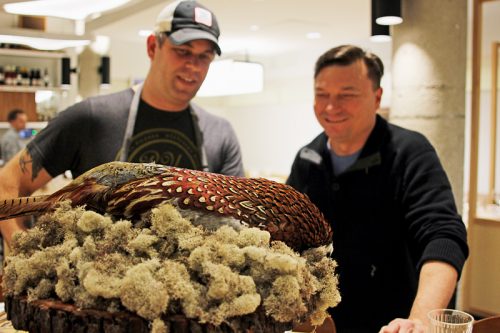
Nathan Sears (theWit hotel) and David Yourd inspect a table centerpiece.
“Where our generation was kind of molecular gastronomy, Ian’s generation is what’s foraged,” Kimble says.
What trend their products don’t fit, however, is “local.” Yourd and Kimble say that was an issue when they were importing so many Spanish things, too. “We believe in it too, when it’s appropriate—but then there’s always ‘the best.’ You don’t grow boquerones in Lake Michigan,” Yourd says. “We keep our portfolio really condensed in New York, for the best from where it’s indigenous to, where it grows the best.”
I say they’re selling “all over the country,” but there was one exception to that. As Kimble says, “We made Ian compromise a little bit for the last five years by not doing anything in Chicago. We sort of owe it to him to go back to our roots.” But the non-compete agreement they had with Fortune expired a few weeks ago. And this party—well, it’s kind of a coming-out party for Yourd, Kimble and Regalis, finally selling to the chefs that they know best—a few of whom were invited to cook for the party.
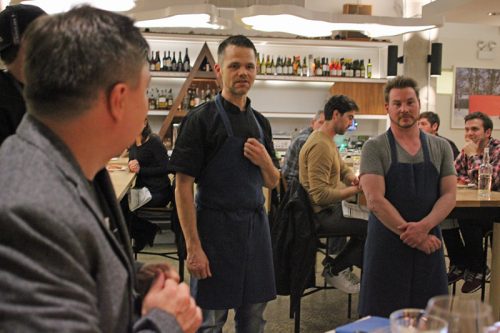
Leonard Hollander (Arbor) introduces a dish; Trevor Teich (Claudia) at right
IF DAVE YOURD CAME INTO THE FOOD BUSINESS the old-fashioned way, Ian Purkayastha represents a new class of—no, actually he sounds like a made-up character: Truffle Boy, the adventures of an incurably precious high school gourmand.
He started in the truffle business when he was 15 and in high school… in Arkansas. After high school he moved to the big city (New York, to be precise), working for an Italian truffle firm, and on his first day selling truffles he says he was not only told to geddafuckouttahere by every restaurant he tried to see, but got beat up by punks when he got back to his office in Newark. (Too on the nose, the story notes would come back in Hollywood.) And at age 25, he has a memoir called Truffle Boy, the kind of thing that tends to happen when you sell truffles to David Chang.
But it’s all true, and not precious at all when you meet him in person. Purkasyastha credits an uncle in Arkansas for getting him started on his interest in rare and luxurious foods—”I was kind of a loser, and couldn’t get any friends, so he took me under his wing and showed me the outdoors,” Purkayastha says. “He was an avid outdoorsman and taught me how to forage for wild mushrooms.”
Having heard about them, he wanted to try truffles, the most storied and costly of edible fungi. On a trip in Houston, some friends who were taking his family to dinner made the mistake of telling young Ian he could order anything he wanted. He ordered black truffle ravioli with a foie gras sauce. “As soon as I had it, it was this amazing revelatory experience,” and he started reading everything he could about them, with the single-mindedness that only kids can muster.

Bluefin tuna with truffle shavings
His parents weren’t keen on the idea of buying him truffles to cook with—he sells the white ones right now starting at $2600 a pound—so he took some saved-up Christmas gift money “and I found a guy in Provence willing to send me a kilo of black summer truffle.” A kilo turned out to be more than he could cook in time, so he decided to sell them to local restaurants. “There were only about three high end restaurants in Arkansas, so I showed up with a little scale and an invoice book and a box of truffles, and I ended up selling everything and I made a huge profit.”
He kept selling them and reinvesting his profits through high school, his parents driving him to his accounts, and instead of college, he wound up being set up by an Italian exporter as their New York rep, with an office in what he calls a “crappy” part of Newark, on the second floor above a methadone clinic. “It was pretty bleak for a few years, but I was fortunate enough to meet Karrie and Dave, and sell to them in Chicago and do ride-alongs with them to their customers.”
So when the time came, the partners with the experience he needed were right in front of him—Yourd and Kimble. “They’ve really helped with the expansion of Regalis, and now we have an office in Texas—it used to be just me doing all the sales and deliveries, but now we have about ten employees in New York, five in Texas—it’s turned into a much larger thing.”
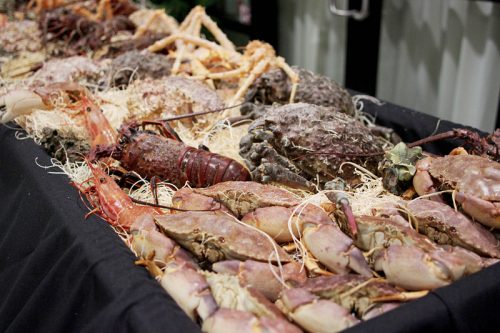
Seafood for the boil
I GOT AN EXCELLENT OVERVIEW OF THE RANGE of Regalis’ product lines by, uh, sticking most of them in my mouth at some point on Monday night. To the varying extent that I have any standard of comparison, it all seemed of extremely high quality—but is that enough to conquer the marketplace?
Unlike the chefs of Arkansas, those in New York or Chicago already have access to truffles, among other rarities—so, I asked Purkayastha, why did he think there was room for him selling such things? “Quality has always been so important to me. Everything that we purvey is of the highest quality,” he says. “Secondly, customer service and transference. The food industry as a whole is a very shady, shadowy, deceitful industry. So our willingness, my willingness to be straightforward and transparent with chefs—and also to be educative.”
“We hand manicure all the mushrooms that go out the door. All the truffles are hand selected and inspected by me, to this day. Chefs go to us when they want really, really high quality.”
Purkayastha continues, “A lot of what we’re specializing in right now is Japanese items. We have our own broker at Tsukiji market, we get five varieties of wasabi, four varieties of uni. We get chrysanthemum flowers, shiso flowers. We have someone in Japan whose specific job is to apply for market access, which is what we need to import certain items. We’re the only company that has a lot of the Japanese ingredients, so we’re picking up a lot of new Japanese [restaurant] customers.”
At that moment, we’re interrupted by someone who says that the chefs want us to be there for the opening of the crates of crabs and lobsters. Ian just has time to sum up Regalis’ business: “Pretty much anything that’s rare and exotic that no one else has, is what we like selling.”
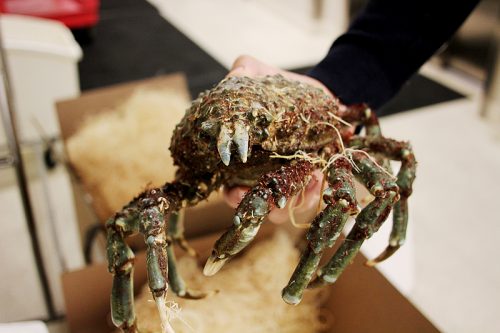
Straight from the crate
Michael Gebert is Editor Boy at Fooditor.
Disclosure: I was a guest for all of this. They also sent me, in advance, a box of assorted items (uni, caviar, matsutake mushrooms, etc.) which I had to figure out what to do with, quickly. And no, I don’t just sit at Arbor all day and wait for rare foods to be brought to me, even if the last two stories at Fooditor could make you think that.
Latest
Join the Discussion
After you comment, click Post. If you're not already logged in you will be asked to log in or register with Disqus.





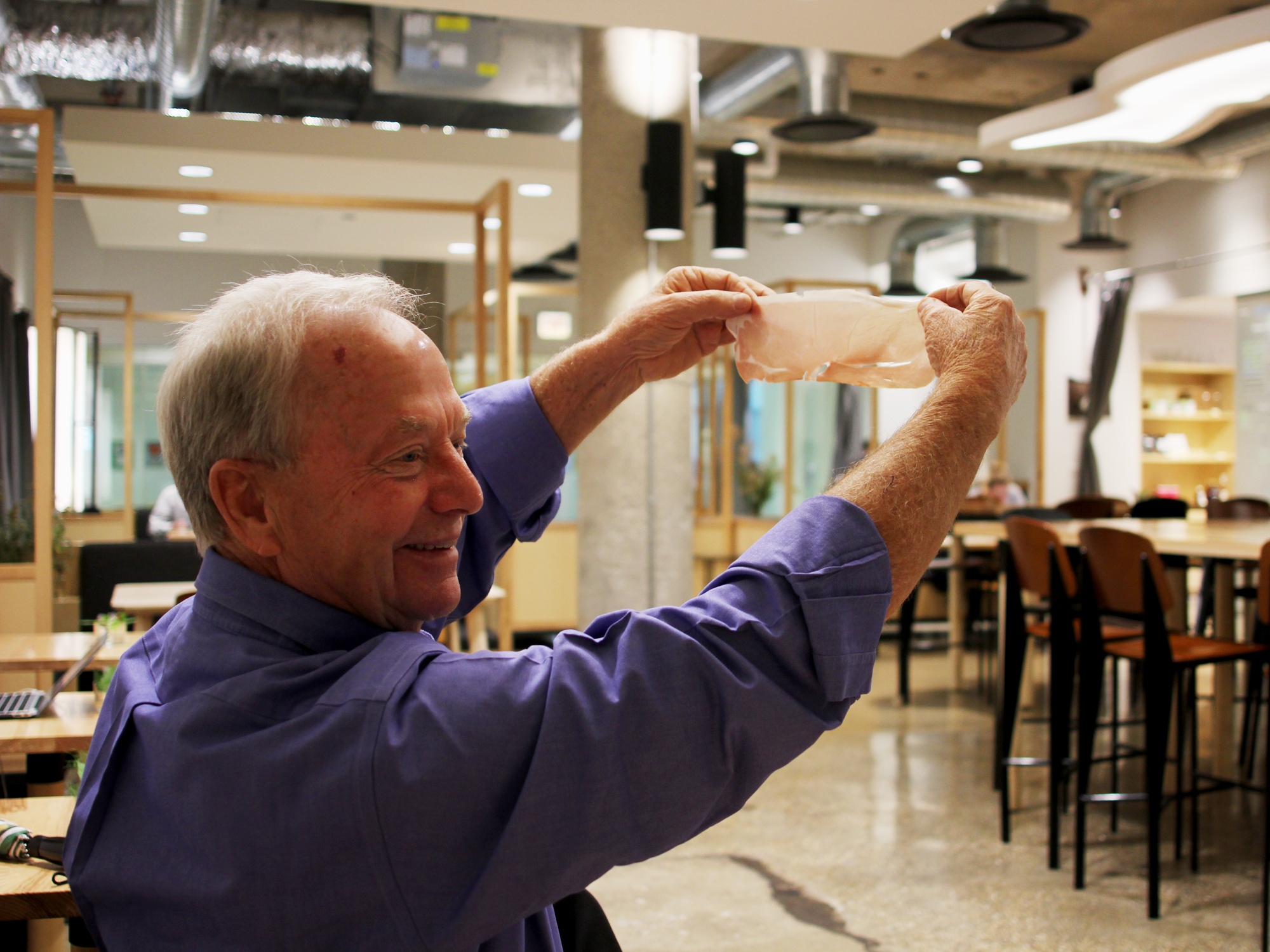

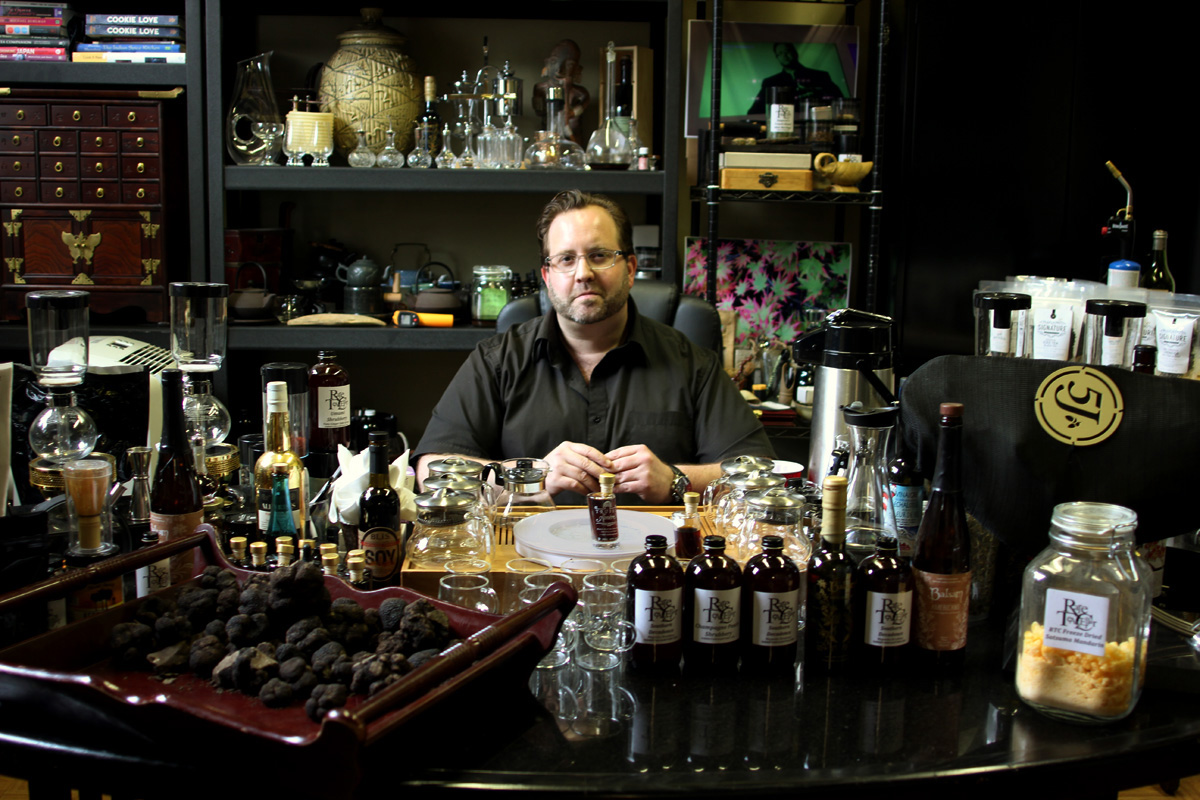
you’re welcome to hang out whenever you like Mike!